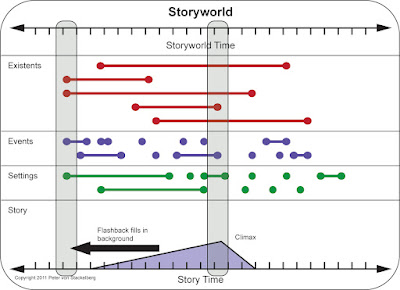The human-centered design approach has nine key principles that can be applied to the design of transmedia narratives.
Coherence
Coherence in a transmedia narrative ensures that the meaning of information embedded in it, even if it is not immediately evident, is not cloaked or obscured. Coherence includes the concepts of transparency and consistency.The design of the entire transmedia narrative experience and the individual elements within it must provide users with enough information that they know what is happening and what is possible within the system. An effective transmedia narrative interface should make its features and functions readily apparent (transparency). However, that doesn’t mean the inner workings of the system need to be on display to users. For example, a button that says “Move to Next Page” makes its function clear without explaining to the user how the move to the next page is handled programmatically.
The design of the transmedia narrative should also be consistent throughout, although that doesn’t mean it must be the same across every element. The kinds of interface elements for which a high level of consistency is important include:
- Interpretation of user actions: Menu items, links, shortcut keys, and other elements involving interpretation of user actions should maintain a consistent meaning throughout the transmedia narrative. It is also important to ensure consistency with the interface of the platform on which the transmedia narrative is presented (Tognazzini, n.d.). For example, a pinch open should zoom in, while a pinch close zooms out. Reversing these gestures would certainly confuse and frustrate an experienced user.
- Invisible structures: Objects that cannot be sensed by the user are invisible structures. Because the user can’t sense them, it is impossible to tell whether these objects are present or not (Tognazzini, n.d.). While generally they should be avoided in designing a transmedia narrative, there may be sound narrative reasons to include an occasional invisible structure. If invisible structures are used, it is very important that they behave in a consistent manner to avoid confusing or frustrating the user.
- Camouflaged visible structures: Objects that can be sensed but don’t appear to be a user control are camouflaged visible structures. In some types of computer games, for example, active objects may be placed in a setting with numerous inactive objects. As a result, users may not discover that these objects can be manipulated. Again, consistency in design and function is important.
- Small visible structures: Icons, size boxes, scroll arrows, and other navigational objects are examples of small visible structures (Tognazzini, n.d.). The appearance and function of these objects needs to be very consistent throughout the transmedia narrative. The location of these objects is only just slightly less important than appearance and function, making a standardize location, highly desirable.
Consistency is also desirable across the user interaction and narrative design aspects of a transmedia narrative (see the appropriate section of this thesis for more detail). However, sometimes inconsistency is necessary within a transmedia narrative. Paradoxically, inconsistencies should be consistent so that when there is a response to a user action, it is consistent with what has happened before. For example, if two different icons are used to jump to a particular page within the transmedia narrative, the way the system handles the jump should be consistent.
Responsiveness
Making the “rules” of a system visible and encouraging users to learn and change them can increase the responsiveness of a transmedia narrative to users’ individual needs, wants, and ways to doing things. The system should offer a “path of least resistance” rather than forcing users to take a single path through the system (Tognazzini, n.d.). Tognazzini uses the analogy of an open landscape, in which users can move as they want, providing an opportunity to explore for those who want to do so while creating and marking a more direct path for users who want to get to an objective quickly or who are new to the system (Tognazzini, n.d.).The transmedia narrative’s design should be forgiving of user actions and errors. A responsive design also gives users a graceful way to undo an action or back out of the path that was selected. It is frustrating to click on a link, only to find it takes you to a place you didn’t want to go. Even more frustrating is not being able to go back to where you were.
Malleability
A system with a high level of malleability can mold itself to suit the users, allowing them to modify the environment to suit their individual aesthetics, skills, and needs. The concept of malleability is closely related to responsiveness. Malleability can be as simple as allowing the user to change the color scheme and font styles of a website to giving users the ability to select the kind of content they want shown via RSS feeds, customized search queries, and so on.Inclusiveness
An inclusive system welcomes users in and makes them feel like they are a part of a community of familiar and friendly activities and individuals. The concept of inclusiveness is closely linked to both responsiveness and malleability. The inclusiveness of a transmedia narrative can be accomplished by adding relatively simple features that recognize and respond to the individual characteristics of the user (i.e. geographic location, age, gender, specific interests, etc.). More complex features like user access to social networking systems linked to the transmedia narrative can also be included. Facebook, for example, provides templates and online instructions on how to create fan pages.These capabilities must be used carefully however as they can have a huge impact on the overall design of the transmedia narrative. (The section in this thesis on user agency discusses the issues involved in this more thoroughly.)





